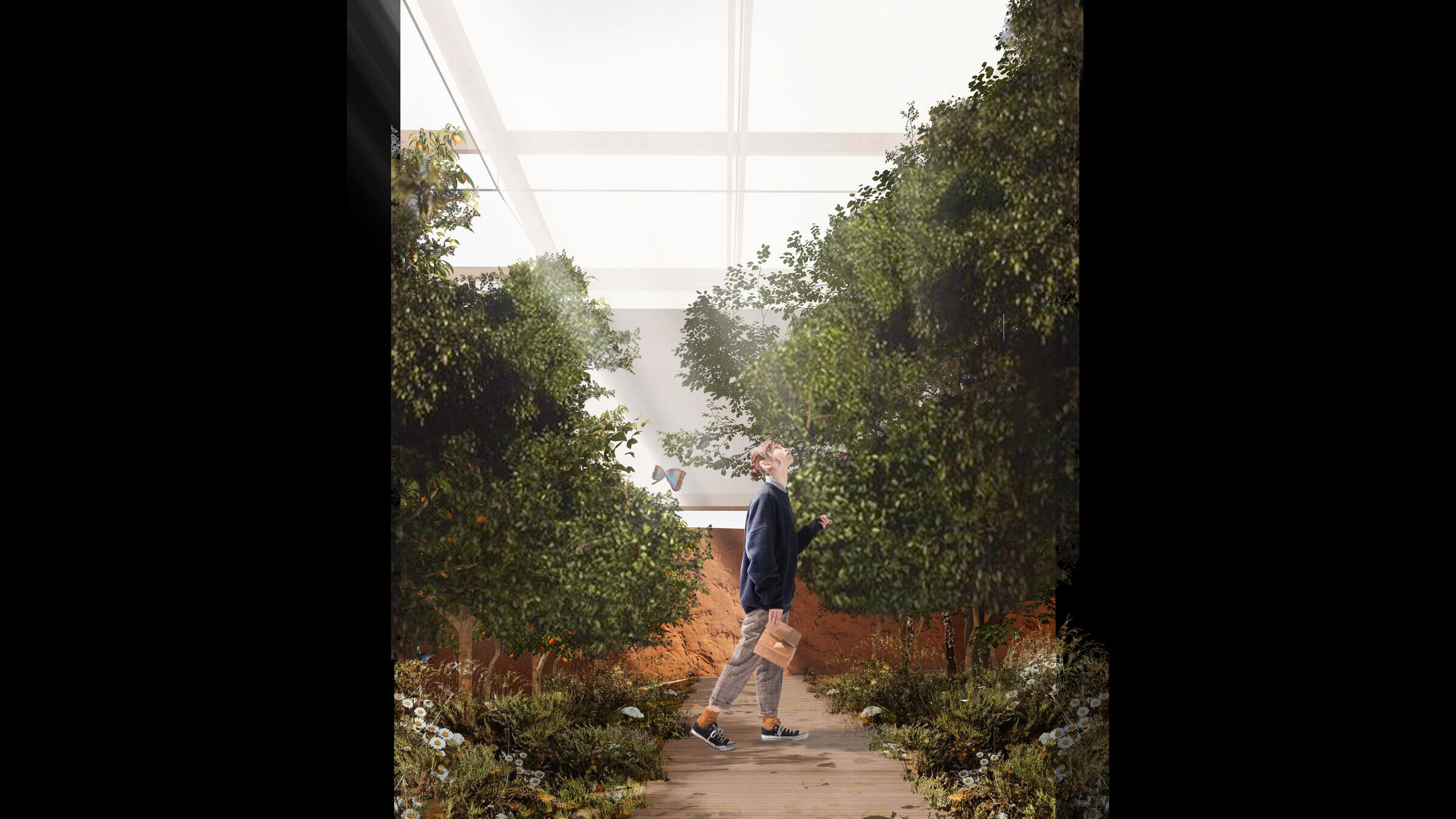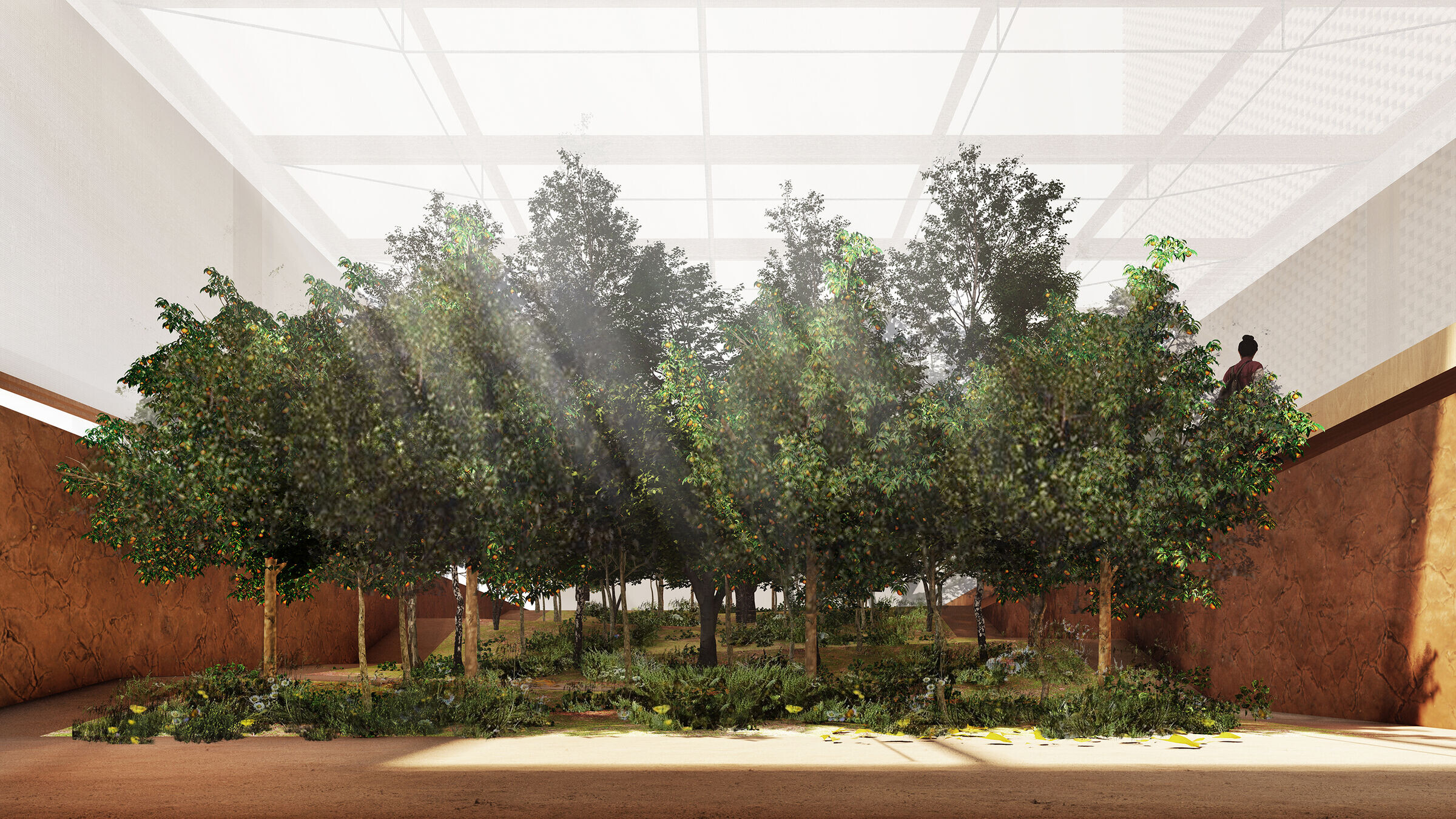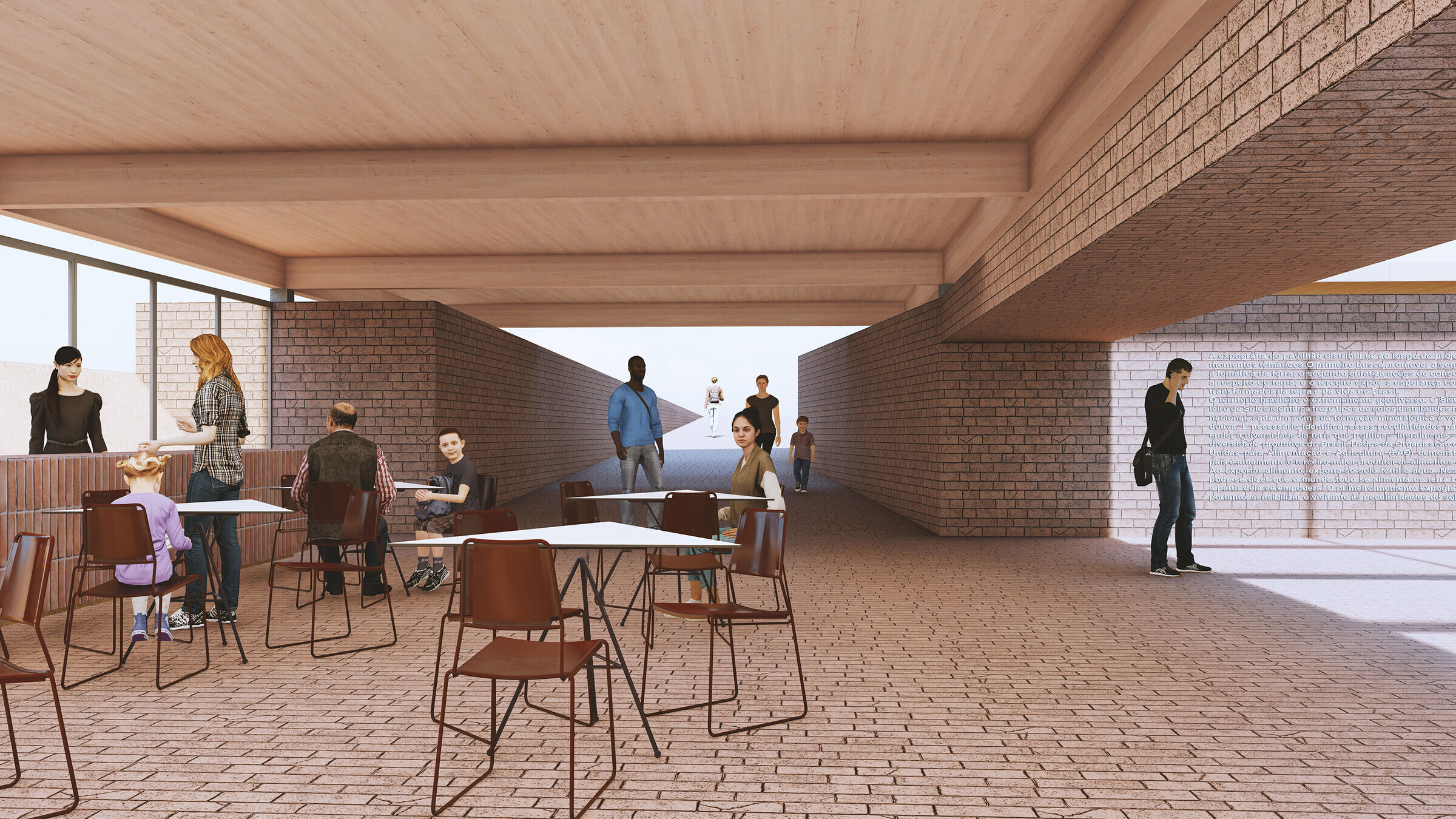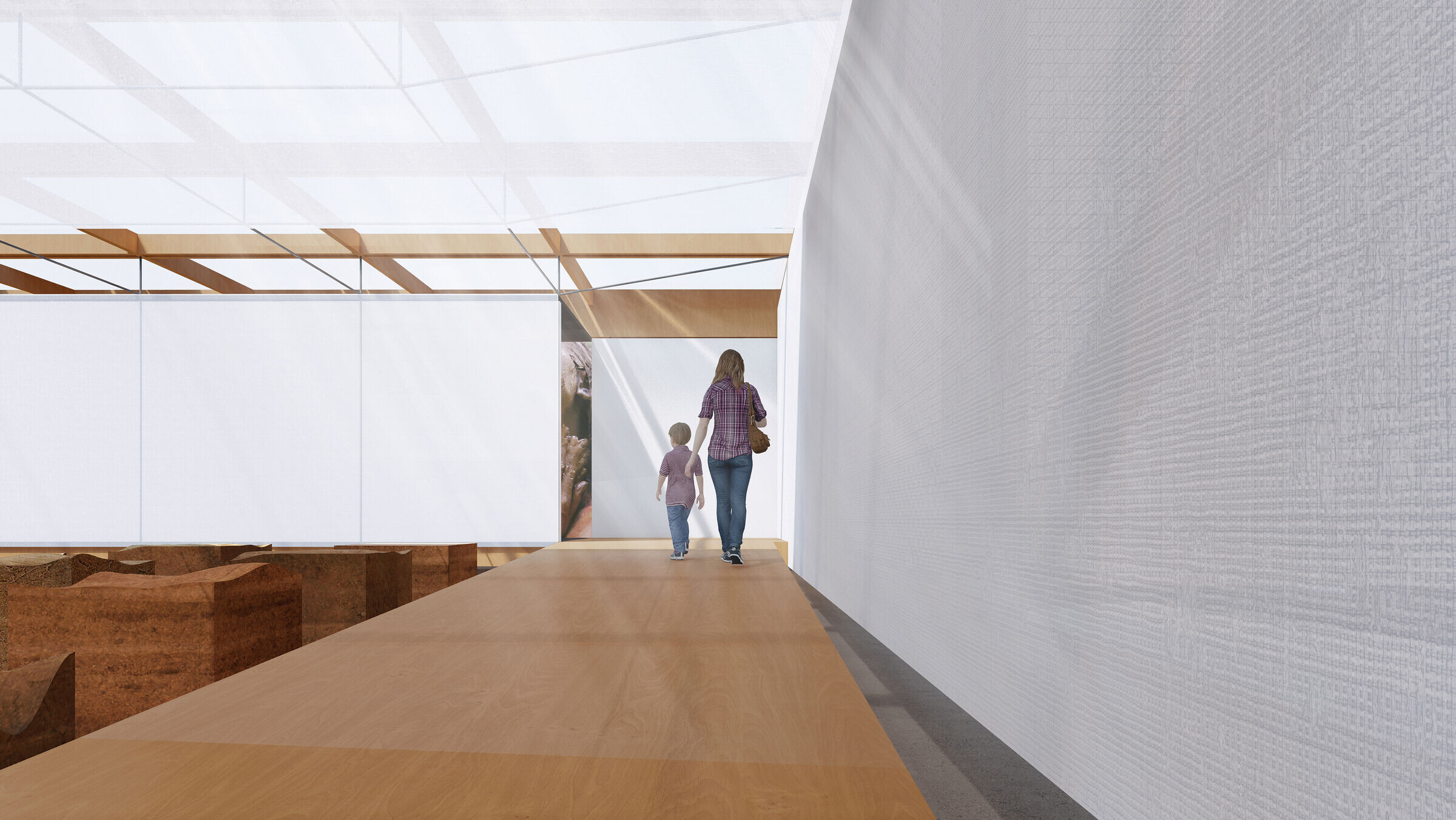honorable mention national architecture competition
The theme of Expo 2025 emphasizes the urgent need to place life as the central and guiding element in discussions about the paths to human development. The term should be understood not only in its everyday dimension but also, and above all, as an indispensable condition for the existence of all species. The pursuit of a better life is a transversal and inherently communal activity: to save, empower, and connect our lives, it is necessary to treat all forms of life equally.
The Brazilian Pavilion is located in the Empower Lives thematic district. The extraordinary diversity of biomes and species coexisting in the national territory makes the country a fundamental player in the international discussion about land management for the maintenance of life in the present and future.
The Earth is considered the great empowering agent – not only for Brazil but for the entire planet. The Earth is the sole source of life; it is the nutritional foundation for all types of production; it is a living archive of the memory of all preceding societies; it is a blank page for the record of our existence. The Earth empowers itself and all forms of life – especially the human species – cyclically, creating an indivisible unity within diversity.
Empowerment means being able to dream; to live beyond survival; to see oneself as an active and transformative agent of one's own land, the driver of one's own life, the master of one's own story. Empowerment means becoming free, sovereign, hopeful for a better future for oneself and for one's land.

Empowerment is the guiding thread of transformation. To transform, one must empower themselves, and for that, they need the Earth. Brazil's close relationship with the Earth presents significant transformative potential.
The project for the Brazilian Pavilion aims to present to the world the image of a country that seeks not a new path in the Earth but a new way of walking; a sovereign nation, a protagonist in the management, fertilization, and stewardship of its natural resources.
It is within the context of reflection on the Earth – the empowering agent of life – that the proposal for the pavilion is situated. The Earth has multiple dimensions: it is a construction material, a shelter; it is soil, ground, and home. The Earth is a document, the archive of the world's memory; it is the world itself.
The treatment of the Earth is the main driver of the pavilion's architectural concept. The project's implementation involves moving the Earth to create slopes, inclined planes, openings, and closures that configure the paths of the building. The project invites discovery through walking, a concept historically present in Brazilian architecture.

The constant state of alert and concern to which humans are subjected has led them, as philosopher Ailton Krenak puts it, to be "as far from the Earth as they are from the Moon." Through walking on a path carved and sculpted from the Earth, visitors experience a reflection on what the Earth is and how it is possible to reconnect with it. In this sense, the building does not appear as an artifact emerging from the Earth, contradictory to it. In the project, the Earth transverses architecture, program, exhibition, and path.
Two distinct blocks, connected by the movement of the Earth, make up the pavilion: the first, dedicated to the exhibition, is horizontal; its translucent closure seeks to bring light to the exhibition path and the palpable Earth at ground level. The second block, vertical, houses the intimate part of the program; the hermetic tectonics of the facades draw attention to another aspect of the Earth – the monumental, capable of standing out from the ground level and creating large formations and vertical planes.
Access to the pavilion is via a ramp descending from the exhibition park level to the entrance hall, located in the second block. From there, visitors can access the central gallery and cultural space of the exhibition building, which opens to the public with a double-height ceiling. This process of immersion in an intimate environment and subsequent rediscovery of light is a characteristic feature of architecture in Brazil, present in the verandas of bandeirista houses, in major modernist works, and in Yanomami shabonos.
From the cultural space, the exhibition path unfolds, distributed on inclined planes and walkways that always emphasize the Earth's role in the pavilion.

The Earth plays a central role in the exhibition in terms of content and materiality. The flooring and walls of the semi-buried level are made of raw adobe bricks, a material with a light ecological footprint that directly relates to the main theme. The facade of the vertical block is also clad with adobe bricks, forming a uniform surface on the front facade and arranged to create cobogós on the side facades. The facade masonry is reinforced with steel rebars to ensure stability.
For the blind facade of the vertical block, a mapped projection of images or films is proposed during nighttime periods to highlight the pavilion and even allow for open-air cinema sessions for visitors.
In addition to adobe, three materials are present in the project: wood, which forms the structure of both blocks in the form of MLC beams and columns, as well as floor and ceiling covering in the vertical building; cellular polycarbonate, a translucent material that covers the roof of the horizontal block to provide ample lighting for the exhibition path; and raw linen, a fabric strongly connected to the Earth. The exterior cladding of the exhibition block consists of a sandwich layer of linen and polycarbonate, capable of protecting the building from the elements while maintaining the light and translucent nature of the facades.
The distinct tectonics of the two pavilion buildings aim to emphasize two types of character that the Earth can take: the light, palpable, and moldable character in the horizontal block, and the monumental character in the vertical block. However, both configurations create an aesthetic unity derived from the diverse treatments given to the Earth.

The treatment of cuts and unevenness on the semi-buried level – through variations in elevation, ramps, and inclined planes – contrasts with the rigid modulation of the MLC structure.
In addition to the exhibition path, the building program includes a café/bar and a pavilion store at the entrance, connecting the entrance hall, cultural space, and the start of the exhibition. For the walls of the two spaces, the curatorial team suggests exhibiting Brazilian handicraft products related to the Earth – including, for example, a composition of sand landscapes produced in Majorlândia, CE, or clay pots from the Jequitinhonha Valley, MG. These products can be purchased by visitors in the store. In the café, Brazilian chefs are invited to create a special menu featuring primarily locally available products combined with Brazilian agroforestry-origin foods.
Technical areas and support facilities for the exhibition, store, and café are located in the vertical block of the pavilion at the ground level. Connecting the floors of this block, a large staircase module is located next to the entrance hall. The stair flights are detached from the side walls, and the upper covering of the module is translucent to provide indirect lighting to all floors. Vertical circulation for both the public and service staff is located behind the staircase block.
The first floor features a foyer and an auditorium with a capacity for 40 people, dedicated to thematic sessions and periodic events in the pavilion. Support areas for the auditorium and a pantry occupy the area behind the staircase module.

The second floor includes a lounge and two meeting rooms, in addition to support rooms. The third level features workstations and administrative rooms, while the fourth floor has a restaurant open to the public. The restaurant level opens onto a staircase lookout that allows visitors to have a wide view of the entire exhibition park.
The exhibition design of the pavilion is divided into three thematic sections. The first aims to raise awareness about the Earth's theme; the second emphasizes awareness-raising actions related to the topic, and the third showcases hope as a transformative agent of the Earth and life in Brazil.
Brazil's territory is extremely geodiverse. The Brazilian Soil System identifies thirteen types of soils distributed throughout the national territory, each with its mineralogical formation and productive vocation. Identifying these peculiarities is necessary to understand the diversity of the fruitful Earth – literally – in the immense productive diversity of Brazil. Data from the Food and Agriculture Organization of the United Nations (FAO) demonstrate that the country is currently the third-largest producer of food on the planet. By exporting food, Brazil exports fertile soil and water. In this sense, it can be said that the whole world feeds on Brazilian soil, and through it, becomes empowered. The first expographic moment, therefore, aims to sensitize visitors to the peculiarities of the soil.
Brazilian agricultural production faces numerous challenges. The need to meet the growing demand for commodities and food in the global market urgently requires adapting to new production technologies that are less harmful to Brazilian biodiversity. The country also faces the paradox of achieving record production levels annually while simultaneously witnessing the resurgence of hunger within its borders. It is important to note that ensuring access to safe and nutritious food is one of the Sustainable Development Goals (SDGs) to be achieved by 2030, according to the Food and Agriculture Organization (FAO). Additionally, the issue of democratizing access to land and the need to protect the territories inhabited by traditional communities are also urgent on the international stage. In this context, the second expographic moment aims to expose the paradoxes of Brazilian production and raise awareness among the public about international land-related issues.

However, the challenges of production and export are accompanied by a role of leadership that the country has been assuming in recent decades concerning the development and standardization of more sustainable production methods, focusing on soil fertilization and biodiversity conservation. Brazilian leadership in the fields of research on biofuels, biofertilizers, agroecology, and remineralizers is highlighted – technological alternatives that use production by-products as sources of energy and nutrition for new production chains. These alternatives share the adoption of simple, accessible practices with great potential for mitigating climate change through carbon capture.
The potential of Brazil to innovate and empower lives comes from the study of the Earth – soils, plant species, roots, microorganisms. The Earth is what will ensure sovereignty and future existence for the country and the world. This is the focus of the third moment of the expographic project: hope.
The first moment of the pavilion focuses on the exhibition of artworks and is distributed on an ascending inclined plane with a 2.15-meter elevation difference, accessed from the cultural space. Conceptually, this slope aims to set the visitor in motion. As visitors explore the exhibition, they will encounter an artistic installation of blocks of Earth aligned at the top, distributed on the ascending plane as if rooted in it. Visitors start the journey facing the tallest blocks, and as they ascend, the blocks become smaller, and the horizon opens up. Scale is of great importance for this installation, aiming to sensitize visitors to the various aspects of the Earth: different shades of color, grain size, and composition. The poetic understanding that the soil consists of unity within diversity contributes significantly to the connection intended to be established with the Earth. Two artists, Marlene Almeida and Carlos Vergara, are suggested by the curatorial team to create this installation. Along the expographic path, Frans Krajcberg's Ensemble of Sculptures is also displayed. The walk to the top of the inclined path offers a wide view of the exhibition and a different perspective on the art installation, providing a space for contemplation and reflection.
From the top of the first expographic moment, the journey through the pavilion continues with a suspended walkway that encircles the inclined plane and the central gallery, forming a passageway in contrast to the preceding moment of the exhibition, which was dedicated to contemplation. The walkway, as it encircles the central gallery, has an opaque enclosure, unlike the rest of the building. The walls, floor, and ceiling of the walkway propose a mapped projection of one or more documentaries during nighttime periods, exposing the paradoxes and challenges faced by Brazilian biodiversity and its agents. The main goal of this expographic moment is to raise awareness among the public. Issues to be addressed include production challenges, Brazil's role in global food security, and the issue of land access as a tool for social empowerment. The curatorial team suggests Zahy Guajajara, João Moreira Salles, and Takumã Kuikuro as directors for these documentaries produced specifically for Expo 2025. Accessibility to the content will be provided through an app accessed via a QR code at the entrance to the immersion tunnel. Visitors can choose the audio language for the projections.

The path of the second expographic moment leads, via a suspended walkway, to the top of the third and final expographic environment, distributed on a descending inclined plane with a 2.15-meter drop that returns to the cultural space. The descent gains poetic relevance by emphasizing the path of environmental preservation as an easier and more enjoyable route to take. The walk along this inclined plane features the installation of a real agroforest, planted with Japanese species suitable for the local microclimate. Pre-selected plant species include kinkan, blackberry, cherry blossom, poplar, Japanese grape, blueberry, Japanese plum, linden, pecan nut, eucalyptus, Japanese kiri, and decopom. The pavilion's proposal is to implement Brazilian technologies for managing the exhibition's agroforest to promote national innovations in agroecological production and carbon sequestration for the world. This includes the application of rock powder, remineralizers, and domestic bio-inputs, as well as the demonstration of bioanalysis technologies.

























